How Bipolar Disorder can be treated and managed.
This is the 26th in a series of blogs, using answers I provided to pass Mental Health qualifications. This blog is the start of describing different types of depression, this being the second, about bipolar disorder.
As with many mental health subjects, they can all be massive topics with reams of books written on them. I will aim to break bipolar disorder down into 3 easy to read blogs, describing possible causes, how bipolar disorder can affect individuals and the people around them, and how it can be treated and managed.
I strongly believe there is no one-size-fits all approach to managing any kind of mental health condition. It is the main reason why I am not a massive advocate of medication. I prefer to consider natural, healthy ways to recognise and manage any kind of mental ill health, tailoring each treatment and therapy to suit each individual. I do this from experience. It is what helped me which is why I believe it can help others too.
Examples of symptoms that may occur in a manic and depressive episode.
Manic symptoms
Heightened activity like working or cleaning for days with no sleep, unable to relax and do not feel tired.
Individuals may feel hypersensitivity when manic, struggling with lighting, noise and even the taste of highly flavoured foods. All can feel uncomfortable. Some cannot bear be to be touched.
Agitation and irritability.
Incessant talking.
Hypersexuality and promiscuity.
Risk-taking behaviour, almost as though everything has to help them have a rush of adrenaline.
Frivolous spending with no thought of how to repay.
Heightened confidence and self-belief.
Extreme behaviours can put them, and others lives at risk. Irrational and extreme behaviours could lead to financial problems too.
Depressive symptoms
After a manic episode, the bipolar individual can ‘crash’ sleeping for very long periods of a time.
May wanting to self-medicate.
Just wanting to wrap themselves up in a blanket and hide in the dark. Isolation.
Extreme feelings of deep sadness, guilt, worthlessness.
Suicidal thoughts.
Examples of medical intervention for bipolar disorder.
There is much debate about whether antidepressants are helpful to people with bipolar. Some studies show that they can be triggers for manic episodes.
Taking prescribed mood stabilisers and anti-psychotics.
Omega 3 acids can be beneficial to reduce depressive episodes.
Hospitalisation if symptoms are severe and there is a risk of harm to the individual or others.
CBT during bouts of depression.
ECT as a last resort.
Ways in which an individual with bipolar disorder can help to manage their illness when entering a manic and depressive episode.
Bipolar individuals can self-medicate, usually with substances that are not good for them.
Avoiding situations that can make them hyper sensitive.
Learning to recognise any triggers and take any prescribed medications specifically relating to certain episodes.
Using talking therapies available for help with depression and/or relationship problems.
Looking at potential lifestyle changes to include exercise, diet and activities that are enjoyable,
Learning CBT, meditation and self-hypnosis to manage bouts of depression.
Learning complementary therapies such as Havening, Reiki, Mediation and Mindfulness and Aromatherapy could all help with self-treatment.
Ways in which others can help an individual with bipolar disorder to manage their illness.
Help to learn any triggers so they can prepare themselves and support the individual, guiding them to self-manage if they can.
Attending support groups and relationship counselling with the individual, again showing support.
Learning complementary therapies such as Reiki, Havening and Aromatherapy to help the individual at times when they may not be able to motivate themselves to do so.
Partake in lifestyle changes too, if needed, to show support and encouragement.
Lots of encouragement during times of stability.
On the whole, others have to try and remain calm, supportive, learning to manage their own frustrations and feelings of inadequacies, preparing to be strong and take responsibility for things (like finances) when the individual is not able to.
Local resources and treatments that would be available to an individual experiencing bipolar disorder.
a) Resources
GP’s for referrals to other health professionals, and counsellors as well as prescribing the correct medication for the individual. This can all be part of the care programme.
Community health workers and psychiatric nurses may be able to help the individual recognise the signs and triggers.
Relationship counsellors as well as other counsellors and psychotherapists who may be charitable organisations or paid for privately.
There may be support groups available, who are able to help with the education of the bipolar but also be able to signpost to debt management organisations, and any others the individual may need. The support groups could be local authority funded or charitable organisations, as well as registered businesses who services are paid for by the individual.
b) Treatments
Prescribed medication.
Talking therapies.
CBT for managing depression.
Various complementary therapies such as Reiki, Havening, Aromatherapy can all help with various conditions experienced by an individual.
ECT as a last resort.
The next series of blogs will continue with understanding schizophrenia.
Tracey of PlumEssence Therapies and Training is a qualified stress management consultant, mental health first aider, clinical hypnotherapist and body work therapist focusing on helping reduce and alleviate concerns connected to both physical and emotional wellbeing. Tracey is also a teacher and trainer, delivering workshops and accredited mental health courses.
Tracey is available for a no-obligation chat to see how we could work together on 01889 808388 or tracey@plumessencetherapies.co.uk
